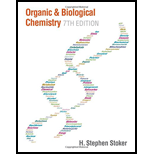
Organic And Biological Chemistry
7th Edition
ISBN: 9781305081079
Author: STOKER, H. Stephen (howard Stephen)
Publisher: Cengage Learning,
expand_more
expand_more
format_list_bulleted
Textbook Question
Chapter 3, Problem 3.40EP
Which member of each of the following pairs of compounds would you expect to be more soluble in water?
- a. 1-Pentanol and 1-butanol
- b. 1-Propanol and 1-hexanol
- c. 1,2,3-Propanetriol and 1-hexanol
Expert Solution & Answer
Want to see the full answer?
Check out a sample textbook solution
Students have asked these similar questions
Fill in the blanks;
______ has a higher boiling point than _________?
a. Carbon dioxide; 1-butanamine
b. Butane; 2-butanol
c. None of these are correct
d. 1-methoxypropane; 2-heptene
e. Cyclohexane; 1-propanol
What kind of solvent ingredients is usually used in the concentrations of 4-10 percent in skin care products and their function is to soften skin cells and to lessen wrinkles?
A. Ethly acetate
B. Alpha hydroxyl acids
C. Phenols and phenol derivatives
D. Aliphatic alcohols
Write the reactions as structural diagrams to represent the reaction that takes place between each alcohol and HCI. Where no reaction occurred, indicate "no reaction"
Chapter 3 Solutions
Organic And Biological Chemistry
Ch. 3.1 - Prob. 1QQCh. 3.1 - Prob. 2QQCh. 3.2 - Prob. 1QQCh. 3.2 - Prob. 2QQCh. 3.2 - Prob. 3QQCh. 3.3 - Prob. 1QQCh. 3.3 - Prob. 2QQCh. 3.3 - Prob. 3QQCh. 3.3 - Prob. 4QQCh. 3.4 - Prob. 1QQ
Ch. 3.4 - Prob. 2QQCh. 3.4 - Prob. 3QQCh. 3.5 - Prob. 1QQCh. 3.5 - Prob. 2QQCh. 3.5 - Prob. 3QQCh. 3.5 - Prob. 4QQCh. 3.6 - Prob. 1QQCh. 3.6 - Prob. 2QQCh. 3.6 - Prob. 3QQCh. 3.7 - Prob. 1QQCh. 3.7 - Prob. 2QQCh. 3.8 - Prob. 1QQCh. 3.8 - Prob. 2QQCh. 3.9 - Prob. 1QQCh. 3.9 - Prob. 2QQCh. 3.9 - Prob. 3QQCh. 3.9 - Prob. 4QQCh. 3.9 - Prob. 5QQCh. 3.9 - Prob. 6QQCh. 3.10 - Prob. 1QQCh. 3.10 - Prob. 2QQCh. 3.11 - Prob. 1QQCh. 3.11 - Prob. 2QQCh. 3.11 - Prob. 3QQCh. 3.12 - Prob. 1QQCh. 3.12 - Prob. 2QQCh. 3.13 - Prob. 1QQCh. 3.13 - Prob. 2QQCh. 3.13 - Prob. 3QQCh. 3.14 - Prob. 1QQCh. 3.14 - Prob. 2QQCh. 3.14 - Prob. 3QQCh. 3.15 - Prob. 1QQCh. 3.15 - Prob. 2QQCh. 3.15 - Prob. 3QQCh. 3.15 - Prob. 4QQCh. 3.16 - Prob. 1QQCh. 3.16 - Prob. 2QQCh. 3.17 - Prob. 1QQCh. 3.17 - Prob. 2QQCh. 3.17 - Prob. 3QQCh. 3.18 - Prob. 1QQCh. 3.18 - Prob. 2QQCh. 3.18 - Prob. 3QQCh. 3.19 - Prob. 1QQCh. 3.19 - Prob. 2QQCh. 3.20 - Prob. 1QQCh. 3.20 - Prob. 2QQCh. 3.20 - Prob. 3QQCh. 3.20 - Prob. 4QQCh. 3.20 - Prob. 5QQCh. 3.21 - Prob. 1QQCh. 3.21 - Prob. 2QQCh. 3.21 - Prob. 3QQCh. 3.21 - Prob. 4QQCh. 3.21 - Prob. 5QQCh. 3 - Prob. 3.1EPCh. 3 - Indicate whether or not each of the following...Ch. 3 - Prob. 3.3EPCh. 3 - Prob. 3.4EPCh. 3 - Prob. 3.5EPCh. 3 - Prob. 3.6EPCh. 3 - Prob. 3.7EPCh. 3 - Prob. 3.8EPCh. 3 - Prob. 3.9EPCh. 3 - Prob. 3.10EPCh. 3 - Write a condensed structural formula for each of...Ch. 3 - Write a condensed structural formula for each of...Ch. 3 - Prob. 3.13EPCh. 3 - Prob. 3.14EPCh. 3 - Prob. 3.15EPCh. 3 - Prob. 3.16EPCh. 3 - Prob. 3.17EPCh. 3 - Prob. 3.18EPCh. 3 - Prob. 3.19EPCh. 3 - Prob. 3.20EPCh. 3 - Prob. 3.21EPCh. 3 - Prob. 3.22EPCh. 3 - Prob. 3.23EPCh. 3 - Prob. 3.24EPCh. 3 - Prob. 3.25EPCh. 3 - Prob. 3.26EPCh. 3 - Prob. 3.27EPCh. 3 - Prob. 3.28EPCh. 3 - Prob. 3.29EPCh. 3 - Prob. 3.30EPCh. 3 - Give the IUPAC name of the alcohol that fits each...Ch. 3 - Prob. 3.32EPCh. 3 - Prob. 3.33EPCh. 3 - Prob. 3.34EPCh. 3 - Prob. 3.35EPCh. 3 - Prob. 3.36EPCh. 3 - Prob. 3.37EPCh. 3 - Which member of each of the following pairs of...Ch. 3 - Prob. 3.39EPCh. 3 - Which member of each of the following pairs of...Ch. 3 - Determine the maximum number of hydrogen bonds...Ch. 3 - Prob. 3.42EPCh. 3 - Prob. 3.43EPCh. 3 - Prob. 3.44EPCh. 3 - Prob. 3.45EPCh. 3 - Prob. 3.46EPCh. 3 - Classify each of the following alcohols as a...Ch. 3 - Classify each of the following alcohols as a...Ch. 3 - Classify each of the following alcohols as a...Ch. 3 - Classify each of the following alcohols as a...Ch. 3 - Prob. 3.51EPCh. 3 - Prob. 3.52EPCh. 3 - Prob. 3.53EPCh. 3 - Prob. 3.54EPCh. 3 - Prob. 3.55EPCh. 3 - Prob. 3.56EPCh. 3 - Prob. 3.57EPCh. 3 - Prob. 3.58EPCh. 3 - Prob. 3.59EPCh. 3 - Prob. 3.60EPCh. 3 - The alcohol 2,2-dimethyl-1-butanol cannot be...Ch. 3 - Prob. 3.62EPCh. 3 - Prob. 3.63EPCh. 3 - Prob. 3.64EPCh. 3 - Prob. 3.65EPCh. 3 - Prob. 3.66EPCh. 3 - Prob. 3.67EPCh. 3 - Prob. 3.68EPCh. 3 - Prob. 3.69EPCh. 3 - Prob. 3.70EPCh. 3 - Prob. 3.71EPCh. 3 - Prob. 3.72EPCh. 3 - Prob. 3.73EPCh. 3 - Prob. 3.74EPCh. 3 - Prob. 3.75EPCh. 3 - Prob. 3.76EPCh. 3 - Prob. 3.77EPCh. 3 - Prob. 3.78EPCh. 3 - Prob. 3.79EPCh. 3 - Prob. 3.80EPCh. 3 - Prob. 3.81EPCh. 3 - Prob. 3.82EPCh. 3 - Prob. 3.83EPCh. 3 - Prob. 3.84EPCh. 3 - Prob. 3.85EPCh. 3 - Prob. 3.86EPCh. 3 - Prob. 3.87EPCh. 3 - Prob. 3.88EPCh. 3 - Prob. 3.89EPCh. 3 - Prob. 3.90EPCh. 3 - Classify each of the following compounds as an...Ch. 3 - Prob. 3.92EPCh. 3 - Draw or write the following for the simplest ether...Ch. 3 - Draw or write the following for the simplest ether...Ch. 3 - Prob. 3.95EPCh. 3 - Prob. 3.96EPCh. 3 - Assign a common name to each of the ethers in...Ch. 3 - Prob. 3.98EPCh. 3 - Prob. 3.99EPCh. 3 - Prob. 3.100EPCh. 3 - Prob. 3.101EPCh. 3 - Prob. 3.102EPCh. 3 - Prob. 3.103EPCh. 3 - Prob. 3.104EPCh. 3 - Prob. 3.105EPCh. 3 - Prob. 3.106EPCh. 3 - Prob. 3.107EPCh. 3 - Prob. 3.108EPCh. 3 - Prob. 3.109EPCh. 3 - Prob. 3.110EPCh. 3 - Prob. 3.111EPCh. 3 - Prob. 3.112EPCh. 3 - Prob. 3.113EPCh. 3 - Prob. 3.114EPCh. 3 - How many isomeric ethers exist when the R groups...Ch. 3 - Prob. 3.116EPCh. 3 - Prob. 3.117EPCh. 3 - Prob. 3.118EPCh. 3 - Prob. 3.119EPCh. 3 - Prob. 3.120EPCh. 3 - Dimethyl ether and ethanol have the same molecular...Ch. 3 - Prob. 3.122EPCh. 3 - Prob. 3.123EPCh. 3 - Prob. 3.124EPCh. 3 - Prob. 3.125EPCh. 3 - Prob. 3.126EPCh. 3 - Classify each of the following molecular...Ch. 3 - Classify each of the following molecular...Ch. 3 - Prob. 3.129EPCh. 3 - Prob. 3.130EPCh. 3 - Prob. 3.131EPCh. 3 - Draw a condensed structural formula for each of...Ch. 3 - Prob. 3.133EPCh. 3 - Prob. 3.134EPCh. 3 - Prob. 3.135EPCh. 3 - Write the formulas for the sulfur-containing...Ch. 3 - Prob. 3.137EPCh. 3 - For each of the following pairs of compounds,...Ch. 3 - Prob. 3.139EPCh. 3 - Prob. 3.140EPCh. 3 - Prob. 3.141EPCh. 3 - Prob. 3.142EPCh. 3 - Prob. 3.143EPCh. 3 - Prob. 3.144EPCh. 3 - Prob. 3.145EPCh. 3 - Prob. 3.146EP
Knowledge Booster
Learn more about
Need a deep-dive on the concept behind this application? Look no further. Learn more about this topic, chemistry and related others by exploring similar questions and additional content below.Similar questions
- Which of the following would be made from an alcohol by a dehydration reaction? A) alkane B) alkene C) alkyl halide D) alkynearrow_forwardWhy does propanal have a Higher boiling point than butane ?arrow_forwardIdenitfy and draw a diagram showing the strongest non-covalent bond between an isopropanol and a 1-propanol molecule.arrow_forward
- Why must a dilute solution of phenol be used for disinfecting environmental surfaces?arrow_forwardWhat kind of solvent ingredients is widely is usually used in mouthwash, perfumes and spray A. Ethly acetate B. Aliphatic alcohols C. Fragrant esters D. Phenols and phenol derivativesarrow_forwardWhat reagents are used in the esterification of Alcohols and Phenols? a.Write the reaction involved in Primary Alcohol (Ethanol) and Acetyl Chloride b. Write the reaction involved in Phenol and Acetyl Chloridearrow_forward
- How do the structure and number of carbons affect the solubility of alcohols in water?arrow_forwardWhat type of product should be formed if butanol went through an oxidation reaction to completion? (A) carboxylic acid (B) ketone (C) no product formed (D) aldehydearrow_forwardWhat is meant by denatured alcohol?What is the need to denature alcohol?arrow_forward
arrow_back_ios
SEE MORE QUESTIONS
arrow_forward_ios
Recommended textbooks for you
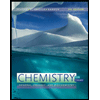 Chemistry for Today: General, Organic, and Bioche...ChemistryISBN:9781305960060Author:Spencer L. Seager, Michael R. Slabaugh, Maren S. HansenPublisher:Cengage Learning
Chemistry for Today: General, Organic, and Bioche...ChemistryISBN:9781305960060Author:Spencer L. Seager, Michael R. Slabaugh, Maren S. HansenPublisher:Cengage Learning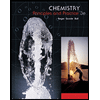 Chemistry: Principles and PracticeChemistryISBN:9780534420123Author:Daniel L. Reger, Scott R. Goode, David W. Ball, Edward MercerPublisher:Cengage Learning
Chemistry: Principles and PracticeChemistryISBN:9780534420123Author:Daniel L. Reger, Scott R. Goode, David W. Ball, Edward MercerPublisher:Cengage Learning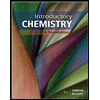 Introductory Chemistry: A FoundationChemistryISBN:9781337399425Author:Steven S. Zumdahl, Donald J. DeCostePublisher:Cengage Learning
Introductory Chemistry: A FoundationChemistryISBN:9781337399425Author:Steven S. Zumdahl, Donald J. DeCostePublisher:Cengage Learning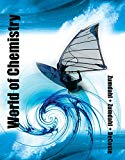 World of Chemistry, 3rd editionChemistryISBN:9781133109655Author:Steven S. Zumdahl, Susan L. Zumdahl, Donald J. DeCostePublisher:Brooks / Cole / Cengage LearningChemistry: Matter and ChangeChemistryISBN:9780078746376Author:Dinah Zike, Laurel Dingrando, Nicholas Hainen, Cheryl WistromPublisher:Glencoe/McGraw-Hill School Pub Co
World of Chemistry, 3rd editionChemistryISBN:9781133109655Author:Steven S. Zumdahl, Susan L. Zumdahl, Donald J. DeCostePublisher:Brooks / Cole / Cengage LearningChemistry: Matter and ChangeChemistryISBN:9780078746376Author:Dinah Zike, Laurel Dingrando, Nicholas Hainen, Cheryl WistromPublisher:Glencoe/McGraw-Hill School Pub Co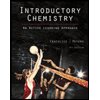 Introductory Chemistry: An Active Learning Approa...ChemistryISBN:9781305079250Author:Mark S. Cracolice, Ed PetersPublisher:Cengage Learning
Introductory Chemistry: An Active Learning Approa...ChemistryISBN:9781305079250Author:Mark S. Cracolice, Ed PetersPublisher:Cengage Learning

Chemistry for Today: General, Organic, and Bioche...
Chemistry
ISBN:9781305960060
Author:Spencer L. Seager, Michael R. Slabaugh, Maren S. Hansen
Publisher:Cengage Learning

Chemistry: Principles and Practice
Chemistry
ISBN:9780534420123
Author:Daniel L. Reger, Scott R. Goode, David W. Ball, Edward Mercer
Publisher:Cengage Learning

Introductory Chemistry: A Foundation
Chemistry
ISBN:9781337399425
Author:Steven S. Zumdahl, Donald J. DeCoste
Publisher:Cengage Learning

World of Chemistry, 3rd edition
Chemistry
ISBN:9781133109655
Author:Steven S. Zumdahl, Susan L. Zumdahl, Donald J. DeCoste
Publisher:Brooks / Cole / Cengage Learning

Chemistry: Matter and Change
Chemistry
ISBN:9780078746376
Author:Dinah Zike, Laurel Dingrando, Nicholas Hainen, Cheryl Wistrom
Publisher:Glencoe/McGraw-Hill School Pub Co

Introductory Chemistry: An Active Learning Approa...
Chemistry
ISBN:9781305079250
Author:Mark S. Cracolice, Ed Peters
Publisher:Cengage Learning
07 Physical Properties of Organic Compounds; Author: Mindset;https://www.youtube.com/watch?v=UjlSgwq4w6U;License: Standard YouTube License, CC-BY